#Jesuits
Text
Ms. Codex 1667 is a diary written by Jesuit brother including discussions of eruptions of Mount Vesuvius and reports of miraculous happenings related to Saint Januarius. Written on paper that's been badly damaged #RainsfordDay
🔗:
#rainsford day#charles rainsford#miracles#17th century#18th century#jesuits#diary#journal#paper#book history#manuscript#rare books
202 notes
·
View notes
Text
The Nightly Examen, Following St. Ignatius:
Place yourself in God's presence.
Pray to understand how God is active in your life.
Recall your day, specifically your faults
Reflect on what you did, said, or thought in those instances.
Look toward tomorrow, figure out how you can improve.
Conclude with an Our Father.
#st Ignatius#st ignatius of loyola#jesuits#Ignation examen#the examen#nightly prayer#prayer#reflection#praying#religion#Catholic#Christian#Christianity#catholicism#catholic church#cristiandad#catolica#catolico#catolicismo#iglesia#iglesia católica#god#jesus
113 notes
·
View notes
Text

Saint John Ogilvie
1579 - 1615
Feast Day: March 10
Patron of Scotland
Saint John Ogilvie was a Scottish Roman Catholic Jesuit martyr, born into a wealthy respected Calvinist family in 1579. In the midst of the religious controversies and turmoil that engulfed Europe of that era, he decided to become a Roman Catholic. He joined the Society of Jesus and was ordained a priest in Paris in 1610. After ordination, he returned to Scotland in November 1613 disguised as a horse trader named John Watson, to minister to the few remaining Roman Catholics in the Glasgow area where it was illegal to preach or otherwise endorse Roman Catholicism. In 1614, he was betrayed and arrested in Glasgow, convicted of high treason for refusing to accept the King's spiritual jurisdiction, suffered terrible tortures and was hanged.
Prints, plaques & holy cards available for purchase here: (website)
54 notes
·
View notes
Text
https://x.com/NewBlackMan/status/1702891802833904057?s=20
er 15, 2023September 15, 2023

Georgetown University and the Jesuits have pledged $27 million in money and land donations to the descendants of 19th-century enslaved people who were sold to fund the highly prestigious institution.
According to CNN, the Descendants Truth & Reconciliation Foundation confirmed the gifts of $10 million from Georgetown and an additional $17 million from the Jesuits in the form of financial retribution and plantation land.
“These contributions from Georgetown University and the Jesuits are a clear indication of the role Jesuits and other institutions of higher education can play in supporting our mission to heal the wounds of racism in the United States, as well as a call to action for all of the Catholic Church to take meaningful steps to address the harm done through centuries of slaveholding,” Monique Trusclair Maddox, CEO of the Descendants Truth & Reconciliation Foundation and chair of its board of directors, said.
The donations hope to be a crucial step in rectifying the injustice enacted upon 272 enslaved men, women, and children sold from Jesuit plantations to settle Georgetown’s debts in 1838.
The long-term plan of Georgetown is to pledge over $1 billion through the Descendants Truth & Reconciliation Foundation. According to CNN, the Jesuits made a $100 million commitment to the efforts in 2021. The foundation will use the funds to invest in the lifelong education of descendants, endow programs invested in anti-racism advocacy, and provide support to elderly descendants throughout their lives.
“It is an honor for our University to have the opportunity to contribute to their efforts. The difficult truths of our past guide us in the urgent work of seeking and supporting reconciliation in our present and future,” Georgetown President John J. DeGioia said.
In recent years, the university and the Jesuits have issued public apologies for the atrocities enacted upon the enslaved by the institution’s founding body.
#$27M Reparations To Be Paid To Descendants Of Enslaved People Sold To Fund Georgetown University#georgetown#freedmen#reparations#survivors of georgetown university slavery debt#jesuits
56 notes
·
View notes
Text

THE DESCRIPTION OF SAINT PAUL MIKI AND 26 COMPANIONS
Feast Day: February 6
"I am not from the Philippines. I am a Japanese and a Jesuit Brother… Having arrived at this moment of my existence, I believe that no one of you thinks I want to hide the truth. That is why I have to declare to you that there is no other way of salvation than the one followed by Christians. Since this way teaches me to forgive my enemies and all who have offended me. I willingly forgive the king and all those who have desired my death. And I pray that they will obtain the desire of Christian baptism." -St. Paul Miki
The first martyr of Japan, Paul Miki was born to a wealthy Japanese family circa 1562 in Settsu, Osaka Prefecture in Kansai region. At a young age, he entered the Society of Jesus and preached the Gospel successfully.
The church had been implanted in Japan fifty years earlier, and counted over 200,000 Christians. In 1588, the Emperor claimed that he was 'God,' and ordered all Christian missionaries to leave the country within six months. Some of them obeyed, but Paul and many others remained secretly behind.
In 1597, Paul was discovered and arrested along with twenty-five companions. They endured tortures and derision through several towns, with their left ears cut off, before being taken to Nagasaki. After making their confession, they were fastened to their crosses, with iron collars around their necks.
Their valor and bravery were wonderful to behold. They gave thanks to God by singing Psalms 25 and repeating: 'Into your hands, Lord, I entrust my life.'
Standing in the noblest pulpit of the cross, Paul said to the people: 'I am a Japanese by birth, and a Jesuit by vocation. I am dying for the Gospel of Jesus Christ. I do gladly pardon the Emperor, and all who have sought my death. I beg them to seek baptism and be Christians themselves.'
Then, four executioners unsheathed their spears and killed all of them in a short time. Their faces were serene, while they kept repeating: 'Jesus, Mary!'
On June 8, 1862, Pope Pius IX canonized him and his twenty-five companions.
#random stuff#catholic#catholic saints#jesuits#society of jesus#paul miki#paulo miki#pablo miki#peter bautista#pedro bautista#twenty-six martyrs of japan
30 notes
·
View notes
Text
While we await the results of St Mary Magdalene vs. St Dymphna, here's another poll for all of you!
Here are some resources to learn more about each of them:
Religious orders in pictures
Most well known religious orders
A video on religious orders
#cistercians#redemptorists#jesuits#salesians#dominicans#franciscans#missionaries of charity#benedictines#carmelites#carthusians#catholic saint tournament#catholic#catholicism#catholic saints#christianity#polls#theology#tumblr polls
64 notes
·
View notes
Text
“[The Jesuits] had contributed to the development of pendulum clocks, pantographs, barometers, reflecting telescopes and microscopes, to scientific fields as various as magnetism, optics and electricity. They observed, in some cases before anyone else, the coloured bands on Jupiter's surface, the Andromeda nebula and Saturn's rings. They theorised about the circulation of the blood (independently of Harvey), the theoretical possibility of flight, the way the moon effected the tides, and the wave-like nature of light. Star maps of the southern hemisphere, symbolic logic, flood-control measures on the Po and Adige rivers, introducing plus and minus signs into Italian mathematics-all were typical Jesuit achievements, and scientists as influential as Fermat, Huygens, Leibniz and Newton were not alone in counting Jesuits among their most prized correspondents.”
- Jonathan Wright, The Jesuits: Missions, Myths and Histories (London: HarperCollins, 2004), 189.
14 notes
·
View notes
Photo
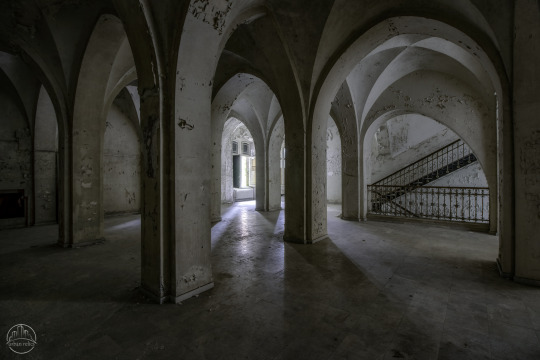

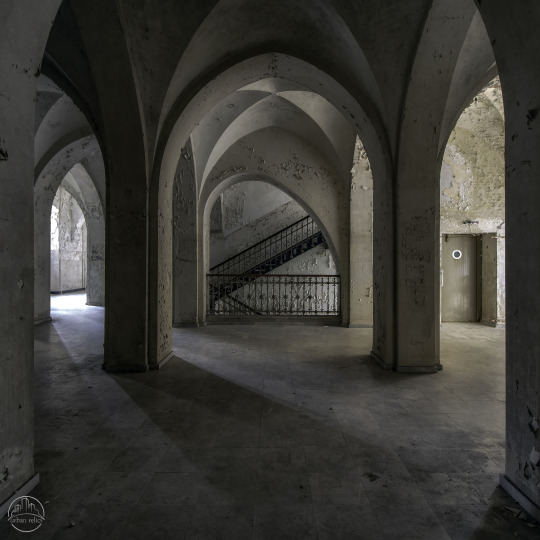

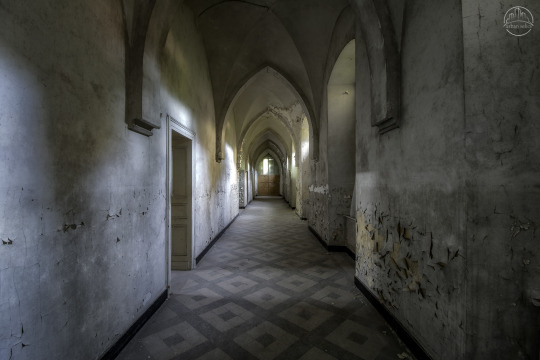

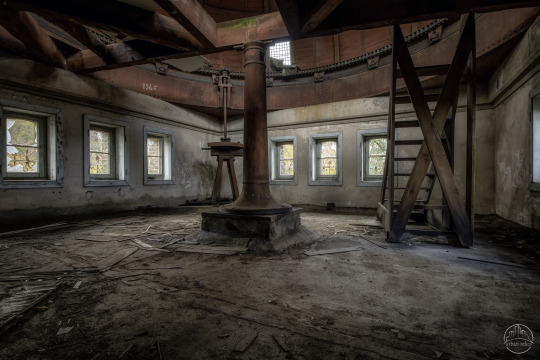

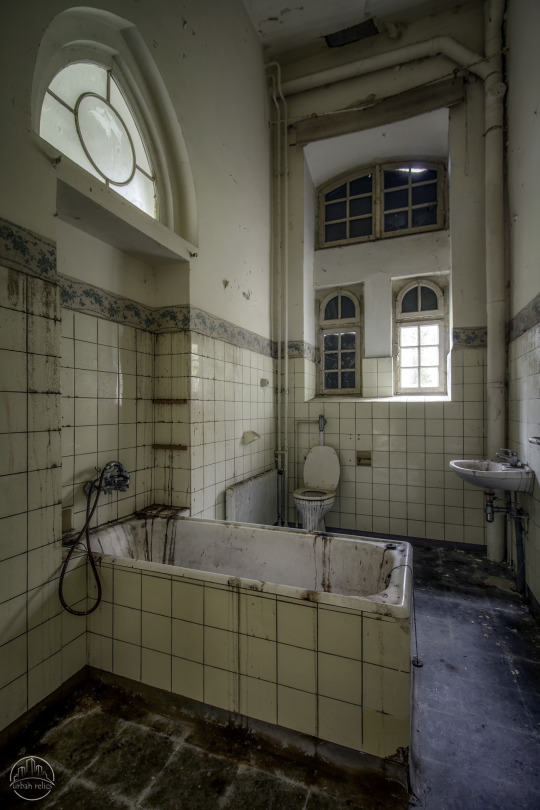

JESUIT MONASTERY
The Kulturkampf of the Protestant Otto von Bismarck banned Catholic monasteries from Germany from about 1870. Numerous monastic orders settled in the border area. This also applies to the order of the Jesuits, which settled in Valkenburg. The Jesuits had conceived the ambitious plan to build the largest building in the Netherlands here. The Ignatius College, as the monastery would be named, was founded between 1893 and 1895 after a design by the German architect H.J. Hürth, who already had several religious buildings to his credit.
The Igatius College became a “Collegium Maximum”, a study and research facility for theologians and philosophers. In addition to the residence cells for the monks, an enormous library with more than 100,000 books and an observatory for the stars was set up. In 1910 a new wing was added, called the 'Moselbrücke'. A group of writing monks settled here with a collection of 70,000 books. The college was attended by professors, writers and students, who enjoyed world fame through their fruitful collaboration with the series ‘Commentaries on the Holy Scriptures’.
During the German occupation of World War II, the Jesuits were again expelled. The SS established the Reichsschule for Boys there in September 1942. The old Gothic chapel was destroyed and completely removed in 1943. From 1944 the complex was used by the Allies as a hospital.
After the war, the complex remained empty for many years, until the Franciscan sisters of St. Joseph settled here in 1961. On their initiative, a new chapel was built between 1962 and 1964 on the foundations of the former Gothic chapel. It turned out to be a "modern" chapel, the style of which clashes somewhat with that of the classical monastery complex. Between 1964 and 1985 the sisters operated the monastery complex as a retirement home, which was known under the name "Huize Boslust".
In 1985 the by now elderly sisters moved into a new monastery, which was established in the garden of the existing monastery. Since then, the Ignatius College has remained empty. The municipality of Valkenburg once had plans to convert the old monastery into a hotel, but those plans were never carried out due to lack of funds. Just before the turn of the century, the monastery was sold to but never used by the Transcendental Meditation Foundation in the Netherlands, which allowed the buildings to deteriorate further. The complex was recently sold again. There is currently no clarity about the plans of the new owner.
#ue#urban exploration#urbanexploration#urbanexplorers#urban exploring photography#urbex#urbexphotography#urbexplaces#urbexworld#religious#monastery#jesuits#abandoned#abandoned places#abandophiles#abandoned_addiction#decay#derelict#photography#canonphotography#urban relics#netherlands
210 notes
·
View notes
Text
Interesting Article 👆 You Decide 🤔
#pay attention#educate yourselves#educate yourself#knowledge is power#reeducate yourself#reeducate yourselves#think for yourselves#think about it#think for yourself#do your homework#do your research#do some research#do your own research#ask yourself questions#question everything#wtf is this#wtf#free masons#jesuits
33 notes
·
View notes
Text
Huh. Cardinal Richelieu had a Scottish Jesuit almoner. His name was Thomas Chambers.
He ended up essentially becoming France’s unofficial ambassador to the Covenanters during the opening of the Wars of the Three Kingdoms, and then the Covenanters’ very unofficial ambassador to Louis (or rather Richelieu) after his return to Paris.
#early modern history#cardinal richelieu#jesuits#scotland#wars of the three kingdoms#history#things that make you go huh
7 notes
·
View notes
Text

Saint Stanislaus Kostka
1550-1568
Feast Day: November 13
Patronage: Poland, Jesuit novices, students, broken bones, heart palpitations, Strake Jesuit College Preparatory, aspirants to the Oblates of St. Joseph, last sacraments
Saint Stanislaus Kostka was born in Poland into a large noble family. At 14, Stanislaus attended a Jesuit prep school, where he exemplified an iron will to live a life of holiness. Once when ill, angels brought him Holy Communion, which prompted his desire to enter the Jesuits. He walked over 350 miles to Rome, where St. Francis Borgia welcomed him into the novitiate. After 10 months, he predicted his own death and died 2 days later on the Feast of the Assumption of a fever.
Prints, plaques & holy cards available for purchase here: (website)
#Portraitsofsaints#Feastday#Saintoftheday#Saintquote#Saintquotes#StStanislausKostka#SaintStanislausKostka#jesuits#patronsaint#patronsaints#saintportrait#Catholicsaint#saintart#catholicillustrator
78 notes
·
View notes
Photo

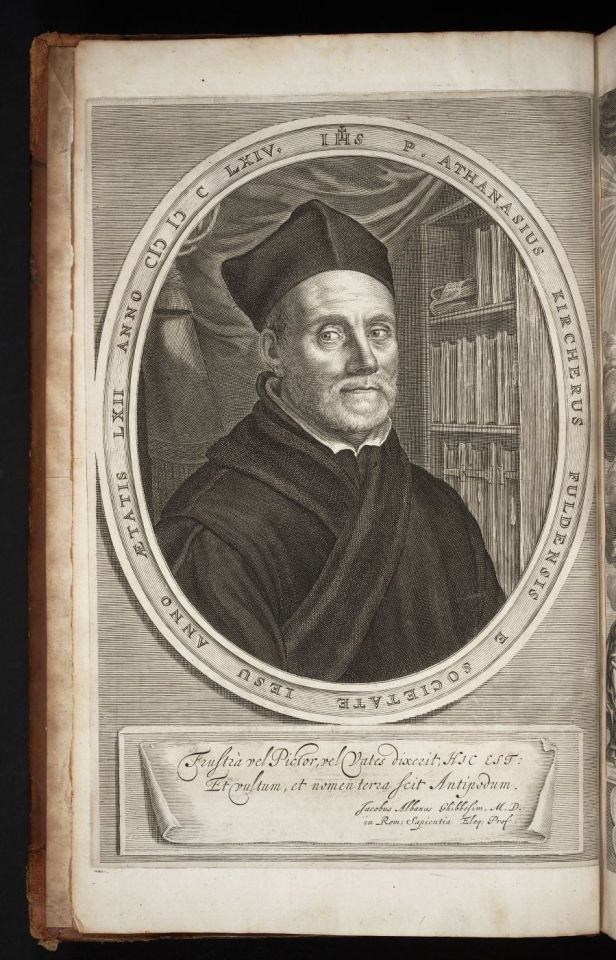





Athanasius Kircher – Scientist of the Day
Athanasius Kircher, A German Jesuit natural philosopher working in Rome, was born May 2, in 1601 or 1602, in Fulda in central Germany.
Learn more
#Athanasius Kircher#fossils#Jesuits#histsci#histSTM#17th century#history of science#Ashworth#Scientist of the Day
38 notes
·
View notes
Text

THE DESCRIPTION OF SAINT PETER CANISIUS
The Jesuit Priest and Holy Apostle of the Catholic Press
Feast Day: December 21
"Better that only a few Catholics should be left, staunch and sincere in their religion, than that they should, remaining many, desire as it were, to be in collusion with the Church’s enemies and in conformity with the open foes of our faith."
Peter Canisius, who is one of the major figures during the Protestant Reformation, called the 'Apostle of the Catholic Press' and known as the Second Apostle of Germany, was born in Nijmegen (located in Gelderland province), Holland (The Netherlands), on May 8, 1521, his mother died shortly after he was born.
In order to please his father Jacob, who is a burgomaster, he studied law for a few months at the University of Louvain. Realizing however, that he was not called to this career, he took a vow of celibacy and went to study theology in Cologne, Germany, where he earned a master's degree at the age of 19. There, while attending a retreat preached by St. Peter Faber, one of the first disciples of Ignatius of Loyola, he decided to enter the Society of Jesus.
After his ordination to the priesthood, he became famous for his talent in preaching. Ignatius considered him a model religious, prepared to go anywhere and to do anything. From Rome, Peter was sent to Germany, where he counteracted the Protestant doctrines and effected a religious revival among the people.
In 1552, Peter was called to Vienna, Austria, where 90% of the people had abandoned the Catholic faith. Many monasteries lay desolate, and not a single priest had been ordained for 20 years. Peter won the heart of the people by his works of charity. He ministered to the sick, visited the prisoners, and cared for the poor.
Realizing the great importance of mass media, he promoted the Catholic press to the best of his ability. During his lifetime, his catechism was reprinted over 200 times and translated into 15 languages.
Despite his success and popularity, Peter remained humble and submissive. He refused to be consecrated bishop of Vienna and Provincial of his order. He died at the age of 76 due to a stroke in Fribourg, Switzerland on December 21, 1597.
Canonized by Pope Pius XI in 1925 and declared a Doctor of the Church the same year, his major shrine can be found in Fribourg.
#random stuff#catholic#catholic saints#jesuits#society of jesus#peter canisius#petrus canisius#pedro canisio#catholic press#doctor of the church
17 notes
·
View notes
Text

Ruins of Jesus de Tavarangue Mission (b.1685) - Itapua, 2016
#picofthenight#travel#paraguay#misiones#original photographers#photographers on tumblr#landscape#ancient architecture#colonial architecture#mission#jesuits#ancient ruins#photoofthenight
13 notes
·
View notes
Text
SAINT OF THE DAY (December 3)

On December 3, the Roman Catholic Church honors St. Francis Xavier, one of the first Jesuits who went on to evangelize vast portions of Asia.
Francis Xavier was born on 7 April 1506 in the Kingdom of Navarre, a region now divided between Spain and France.
His mother was an esteemed heiress while his father was an adviser to King John III.
While his brothers entered the military, Francis followed an intellectual path to a college in Paris. He studied philosophy and later taught it after earning his masters degree.
In Paris, the young man would discover his destiny with the help of his long-time friend Peter Faber and an older student named Ignatius Loyola — who came to Paris in 1528 to finish a degree and brought together a group of men looking to glorify God with their lives.
At first, personal ambition kept Francis from heeding God's call. Ignatius' humble and austere lifestyle did not appeal to him.
But the older student, who had undergone a dramatic conversion, often posed Christ's question to Francis:
“What will it profit a man to gain the whole world and lose his own soul?”
Gradually, Ignatius convinced the young man to give up his own plans and open his mind to God's will.
In 1534, Francis Xavier, Peter Faber, and four other men joined Ignatius in making a vow of poverty, chastity, and dedication to the spread of the Gospel through personal obedience to the Pope.
Francis became a priest in 1537. Three years later, Pope Paul III confirmed Ignatius and his companions as a religious order — the Jesuits.
During that year, the king of Portugal asked the Pope to send missionaries to his newly-acquired territories in India.
Together with another Jesuit, Simon Rodriguez, Francis first spent time in Portugal caring for the sick and giving instruction in the faith.
On his 35th birthday, he set sail for Goa on India's west coast.
There, however, he found the Portuguese colonists causing disgrace to the Church through their bad behavior.
This situation spurred the Jesuit to action.
He spent his days visiting prisoners and the sick, gathering groups of children together to teach them about God, and preaching to both Portuguese and Indians.
Adopting the lifestyle of the common people, he lived on rice and water in a hut with a dirt floor.
Xavier's missionary efforts among them often succeeded, though he had more difficulty converting the upper classes and encountered opposition from both Hindus and Muslims.
In 1545, he extended his efforts to Malaysia, before moving on to Japan in 1549.
Becoming fluent in Japanese, Francis instructed the first generation of Japanese Catholic converts.
Many said that they were willing to suffer martyrdom rather than renounce the faith brought by the far-flung Jesuit.
St. Francis Xavier became ill and died on 3 December 1552, while seeking a way to enter the closely-guarded kingdom of China.
He was beatified by Paul V on 25 October 1619.
On 12 March 1622, both Francis Xavier and Ignatius Loyola were canonized by Pope Gregory XV.
Pius XI proclaimed him the "Patron of Catholic Missions."
9 notes
·
View notes
Photo

St. Ignatius Church through the trees on Charles Square, Prague (infrared photography)
The church was designed by Carlo Lurago in the early Baroque style, and built between 1655 and 1677. The church was built as part of the new Nove Mesto residence of the city's Jesuits, the third largest Jesuit complex in Europe, and dedicated to their patron saint and founder of the Jesuit Order, St. Ignatius of Loyola.
The top of the facade carries a statue of St. Ignatius Loyola, placed there in 1671, with a halo surrounding his whole body. This feature was considered controversial at the time it was installed, as such a decoration was only considered appropriate for statues of Jesus Christ.
#photographers on tumblr#original photographers#black and white#infrared photography#trees#church#st. ignatius church#kostel svatého ignáce z loyoly#karlovo náměstí#charles square#st. ignatius of loyola#jesuits#praha#prague#baroque#infrared
72 notes
·
View notes